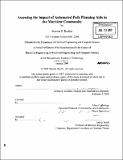| dc.contributor.advisor | Mary Cummings. | en_US |
| dc.contributor.author | Buchin, Mariela E | en_US |
| dc.contributor.other | Massachusetts Institute of Technology. Dept. of Electrical Engineering and Computer Science. | en_US |
| dc.date.accessioned | 2010-03-25T15:01:10Z | |
| dc.date.available | 2010-03-25T15:01:10Z | |
| dc.date.copyright | 2009 | en_US |
| dc.date.issued | 2009 | en_US |
| dc.identifier.uri | http://hdl.handle.net/1721.1/53101 | |
| dc.description | Thesis (M. Eng.)--Massachusetts Institute of Technology, Dept. of Electrical Engineering and Computer Science, 2009. | en_US |
| dc.description | Includes bibliographical references (p. 84-88). | en_US |
| dc.description.abstract | In the area of merchant maritime navigation, electronic charts are a relatively new tool. As a result, navigational path planning environments that allow users to manually enter a path onto an electronic chart are becoming popular, especially in high-end civilian vessels. In military naval operations, however, the switch to newer technology for navigation is taking longer, as there is higher risk due to the weapons and sometimes nuclear reactors onboard. There also appears to be a pervasive lack of trust in automation. In order to incorporate automation into both military and commercial navigation tasks, a system must be designed that is not only efficient in aiding the planning, but also trustworthy to a user. Currently in military submarine and surface ship navigation, paths are planned and re-planned using paper charts, pencils, and rulers, and while these paths are adequate, they are often not optimized based on the depth, weather, and surrounding contacts. As part of a larger research project that is developing a tool to bring more situational awareness to a submarine commander, this thesis develops and implements an automation and visualization to aid submarine commanders in surface navigation. To achieve this, this thesis incorporated design requirements for creating such an automated tool in the development of an automated path planning tool, and then tested the resulting product on human subjects. The results showed that the automation was successful at reducing the time required to generate an optimized path for a set of changing input parameters. The results also showed that the tool was trustworthy, promising high potential for use in commercial and military environments. | en_US |
| dc.description.statementofresponsibility | by Mariela E. Buchin. | en_US |
| dc.format.extent | 88 p. | en_US |
| dc.language.iso | eng | en_US |
| dc.publisher | Massachusetts Institute of Technology | en_US |
| dc.rights | M.I.T. theses are protected by
copyright. They may be viewed from this source for any purpose, but
reproduction or distribution in any format is prohibited without written
permission. See provided URL for inquiries about permission. | en_US |
| dc.rights.uri | http://dspace.mit.edu/handle/1721.1/7582 | en_US |
| dc.subject | Electrical Engineering and Computer Science. | en_US |
| dc.title | Assessing the impact of automated path planning aids in the maritime community | en_US |
| dc.type | Thesis | en_US |
| dc.description.degree | M.Eng. | en_US |
| dc.contributor.department | Massachusetts Institute of Technology. Department of Electrical Engineering and Computer Science | |
| dc.identifier.oclc | 502440533 | en_US |
